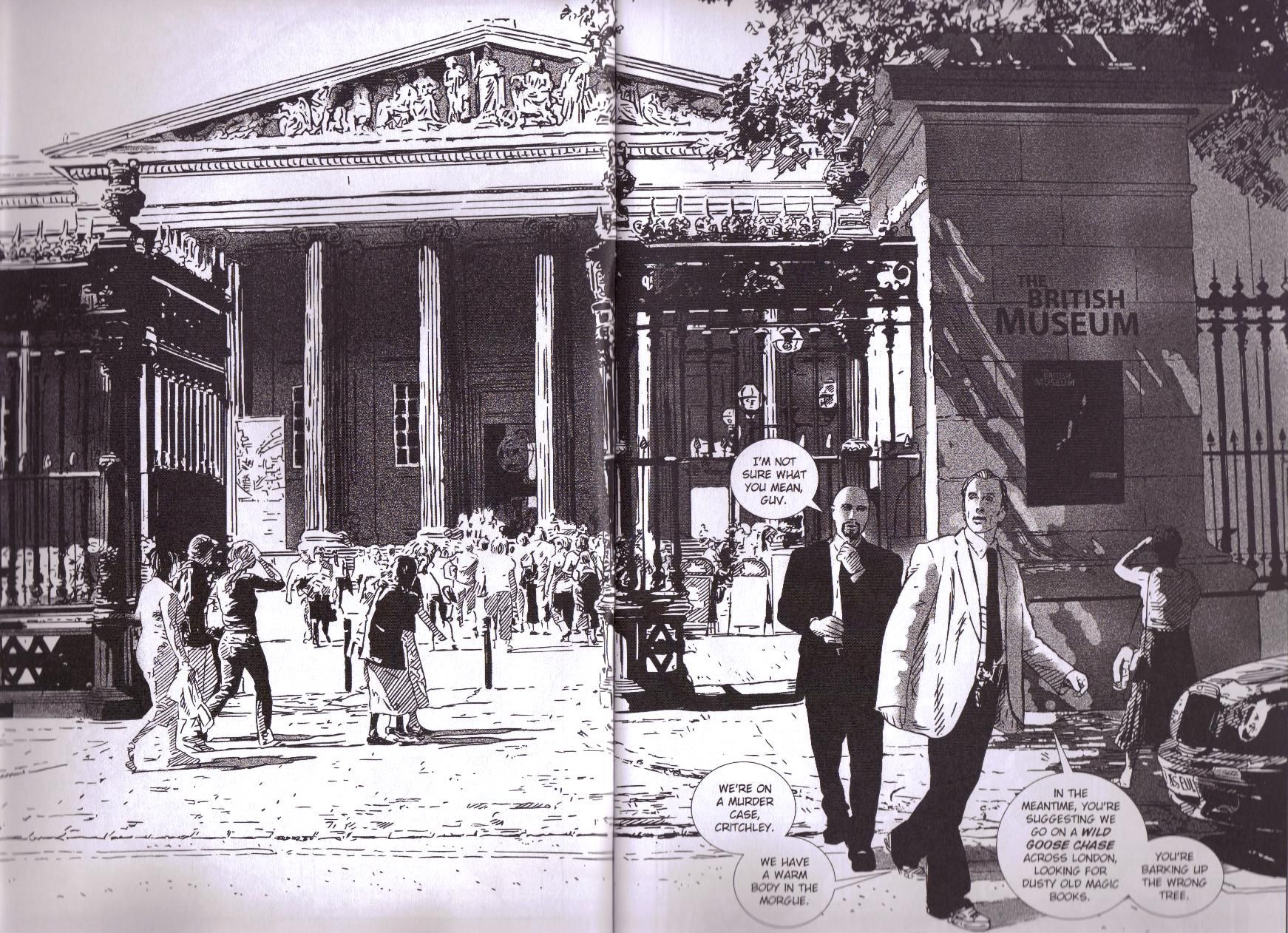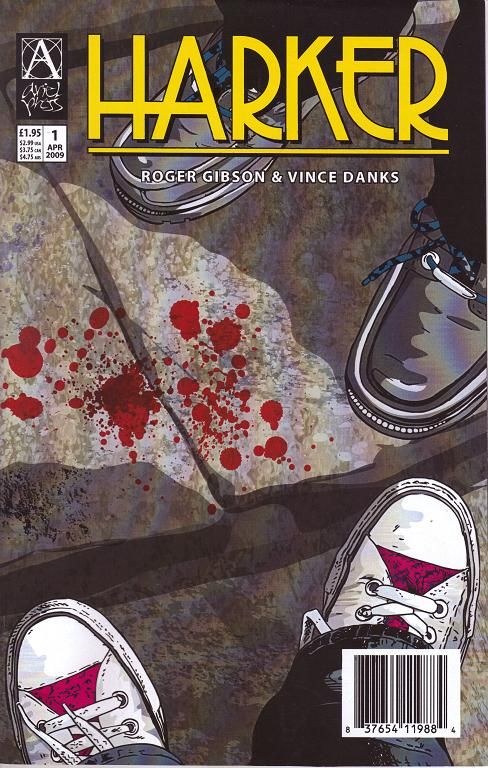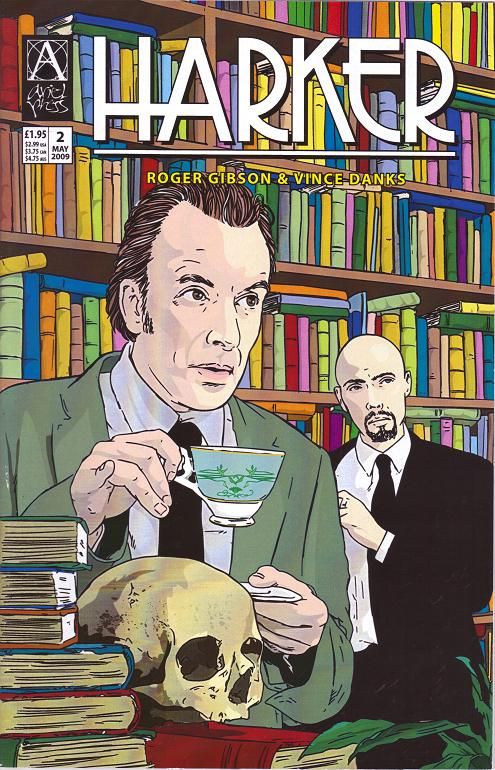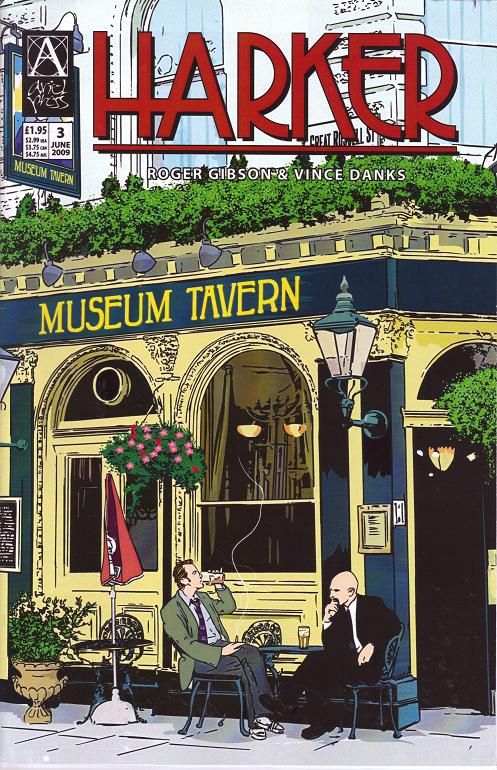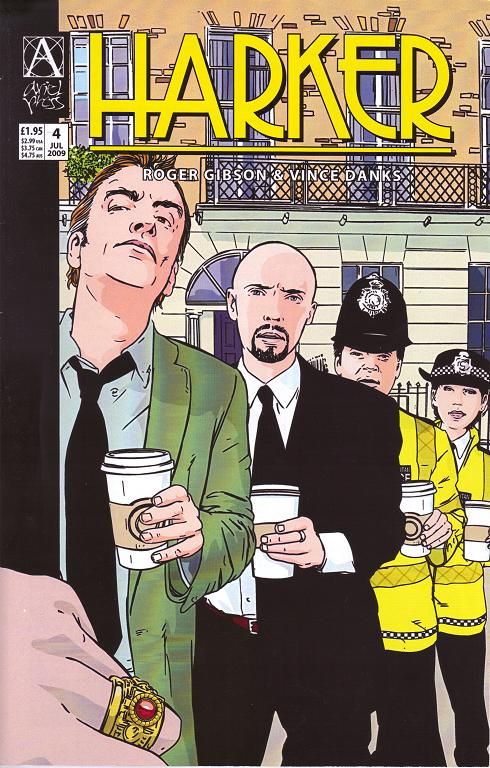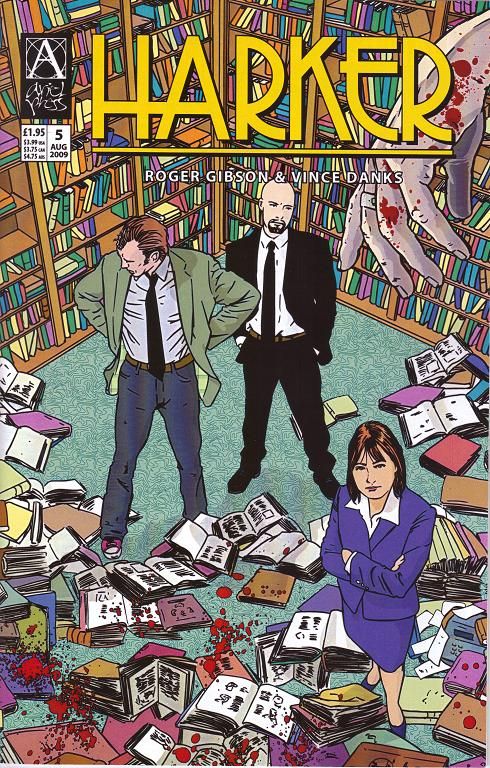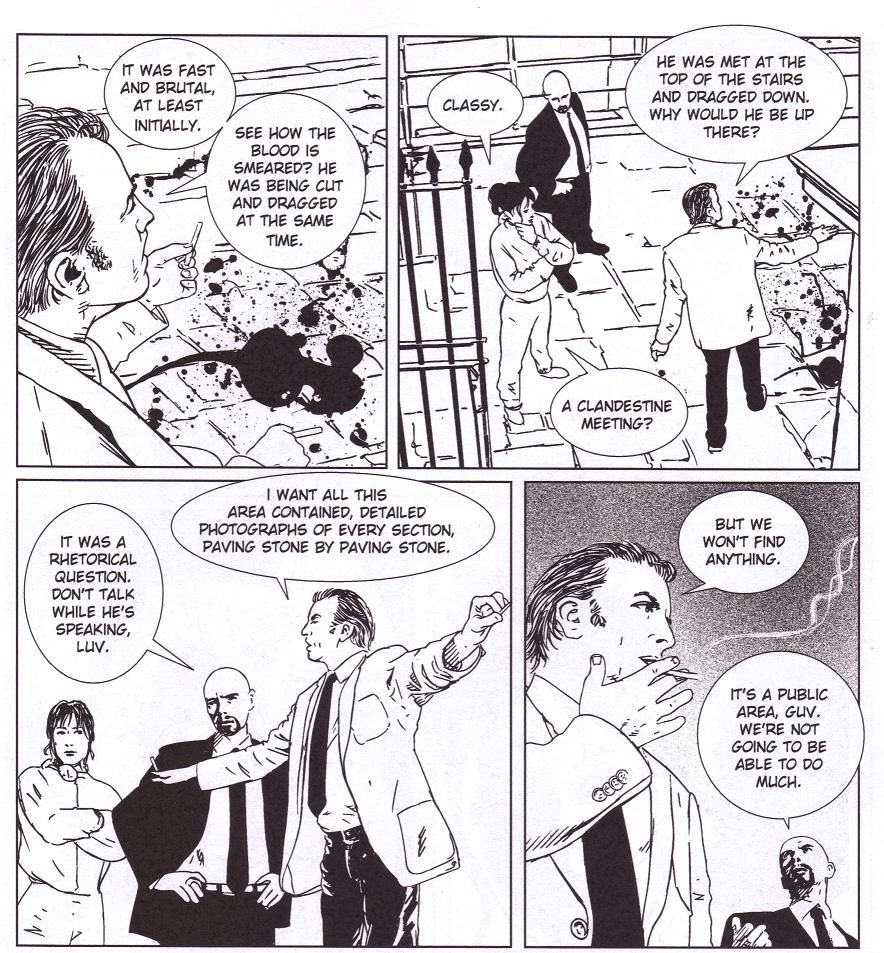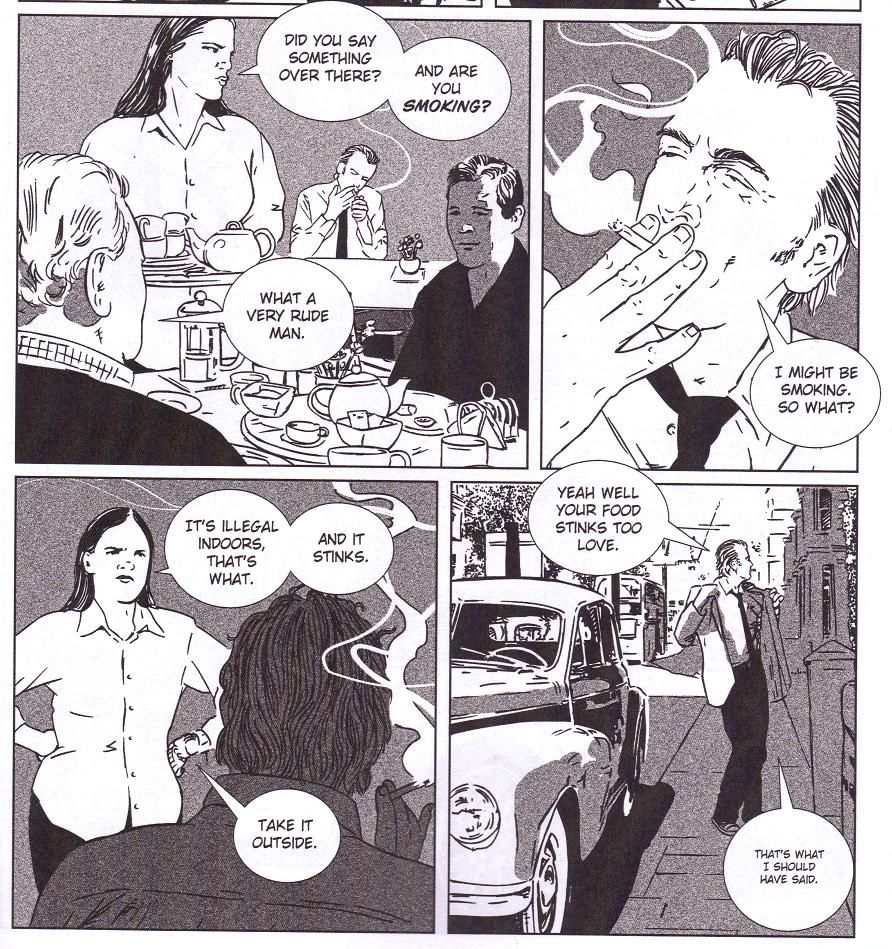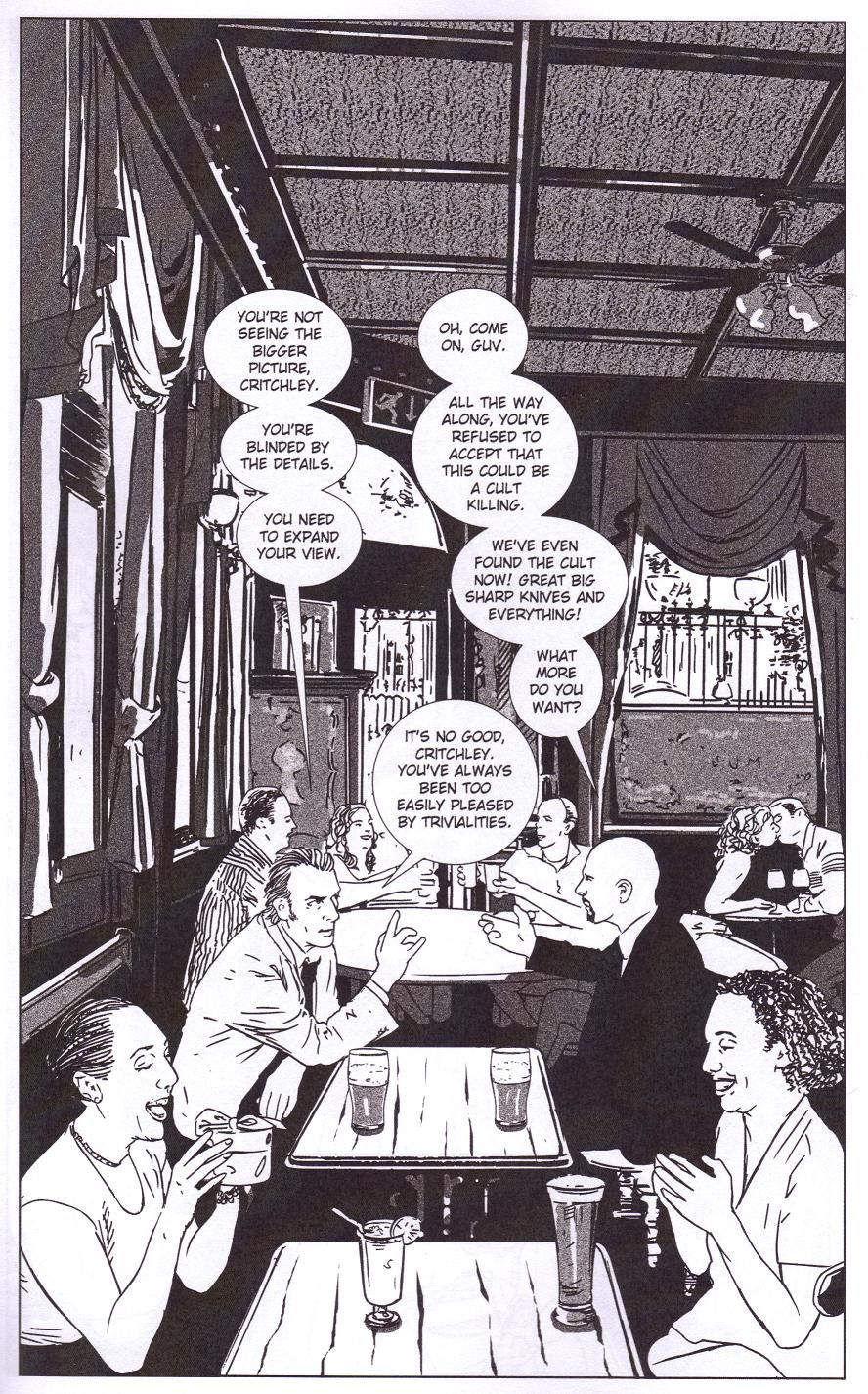With the annoying reality of Previews offering fewer comics in their listings because of raised sales thresholds, it's made getting tinier comics a bit more difficult. Luckily, in the world of the Internet, you can find web sites and order from there! Such is the case with a comic I recently received in the mail ... all the way from Merrie Olde England!
Back in April, I reviewed Harker #1, a new comic about two London police detectives who get called in on the murder of a man on the steps of St. George's Church, Bloomsbury. The second issue was solicited in Previews, but I assume due to their new benchmarks (you remember all this, right?), it never showed up, and subsequent issues weren't listed. Oh dear. However, Harker lived on, with each issue coming out when it was supposed to. Recently I decided to pony up for all the issues that currently exist (issue #9 is the most recent one) and read them all! Actually, as the first story arc ended at issue #6, I decided to just read those. I'll get to the second arc in good time!
So, Harker #1-6 by Roger Gibson and Vince Danks. It's published by Danks' Ariel Press. There's a blog, too, which is kind of neat (I'll get back to the blog). What's the deal with this book?
Well, it's a police procedural/detective book. Absolutely nothing fancy. Nobody is a psychic detective, nobody talks to ghosts, nobody has some weird superpower but hides it to solve crimes - it's just Harker and Critchley, Detective Chief Inspector and Detective Sergeant, respectively. They have their quirks - Harker is a bit ADHD and squeamish around bodies and such, while Critchley is suave, sophisticated, a ladies' man ... and a comics geek. It's actually kind of neat that Gibson doesn't make a big deal about it - Critchley makes a vague reference to From Hell when he discovers where the body was found (the church plays a significant role in Moore's epic) and that's it, but it's enough that we can figure out he's a fan. The writing in the book stands or falls on Gibson's handling of Harker and Critchley, because as good or bad as the actual plots are, if we don't enjoy the banter between the two main characters, it's going to be a tough sell for Gibson.
Luckily, Gibson is up to it. Both Harker and Critchley come across as realistic policemen, and their relationship, which is at the heart of the book, works very well. Critchley appears to be the dominant one in the relationship, but that's mainly because he's much more outgoing than Harker. While both men know what they're doing, Harker appears to be the one who focuses on the more mundane aspects of the world, while Critchley is given to flights of fancy. That means they bounce off each other quite well in this arc, which deals with ritualistic murders and a demonic book and a Satanic cult. Critchley immediately makes the connection to Hawksmoor that Alan Moore did in From Hell, and when evidence keeps coming up that the murders (more people get offed as the book moves along) are somehow connected to a Satanic cult, he's more than willing to keep looking in that direction. Harker, meanwhile, remains skeptical throughout, even as the evidence piles up. Gibson does a very nice job with the tension between the two, because they obviously have a strong rapport and a long friendship, which gives them license to pick on each other even as they're working out the clues. It's nicely done, and keeps the reader wondering which man is really on the right trail (yes, the name of the book might give it away, but Critchley is just as much a main character as Harker is, so that doesn't really tell us much, does it?).
Gibson also does a good job leading us through the procedural part of the comic - I have no idea how "true to life" it is, because I'm not a police detective, but it feels real, and that's often what matters. Harker and Critchley pursue leads, formulate theories, interview suspects - you know, what policemen do - but Gibson does a nice job walking us through it as well, and the reason it doesn't get boring is because the two characters are so interesting. He also keeps confounding our expectations - when the Satanic cult is uncovered, at the end of issue #2, we think the book has taken a turn for the very weird. But at the beginning of issue #3, Gibson throws a curve at us, and forces us to re-evaluate what we've been expecting. He does this throughout the book, which is kind of neat. The biggest problem with the book is the ending. Without giving too much away, Harker and Critchley don't really assemble clues and figure things out - it's much easier than that, and doesn't show us exactly how brilliant they are. They're good policemen, certainly, but are they brilliant? It would have been nicer if we, as readers, had slapped our heads and said, "Wow, that was impressive!" It's a nifty story, but it's much more interesting for the way Harker and Critchley go about doing the police work and bouncing ideas off each other rather than the resolution of the case. Perhaps that was what Gibson was going for, as this is their first adventure. If so, he succeeded in, at least, giving us two interesting characters and what, on the surface, is a decent murder mystery.
Danks is very good on the art. A great deal of it is photo-referenced, but it doesn't look like Harker and Critchley and the other characters are simply laid onto a background - they are part of the scene, and so although we can see the tricks Danks uses, it's a seamless-looking book (and I have no problem with artists using photo-reference - what bugs me is when the parts that aren't don't fit well with the parts that are). The entire book takes place around the British Museum (pretty much one street next to it), and Danks gives us a very good sense of place (Danks lives in the north; Gibson jokes that he probably went broke taking the train down to London so much). His characters are very well designed, too. He keeps in mind the personalities of the two main characters, so Critchley is always very suave while Harker is a bit more scruffy. Danks is good with body language, too - when Harker is confronted with dead bodies, we can see his squeamishness even before Critchley or even Harker comments on it (and they don't do it all the time, which makes the times when they don't nice character moments for Harker). There's not a ton of action in the book, but Danks does a good job with that, too. Mostly, he just immerses us in this small area of London, which makes the comic much more interesting due to its strong sense of place. At the end of issue #3, when Harker and Critchley sit in a pub rehashing the case, Danks does a marvelous job putting us in the pub with them, not only with the surroundings, but with the other people going about their days. It's a very cool scene.
I'm not totally in love with Harker; as I wrote above, the plot leaves just a bit to be desired. But I do recommend it, because Gibson and Danks give us a fun comic with two characters who get more interesting each issue, and I imagine Gibson will get better with the cases. Harker looks great, and the relationship between the two leads is marvelous. Gibson does nice annotations on the blog, too, which is kind of cool ... although you should read the entire arc before you check out the annotations, because he does imply several things that we only learn in later issues. You can get a trade of the first arc, too. I'm looking forward to reading the next arc - it's in Whitby, and apparently that's going to be the thing with the book; it will go to different locations each arc, which is kind of neat.
You can order the book through the web site, to which I linked above. Give it a try! Who doesn't love it when a detective stops investigating for some cheese and pickles?

